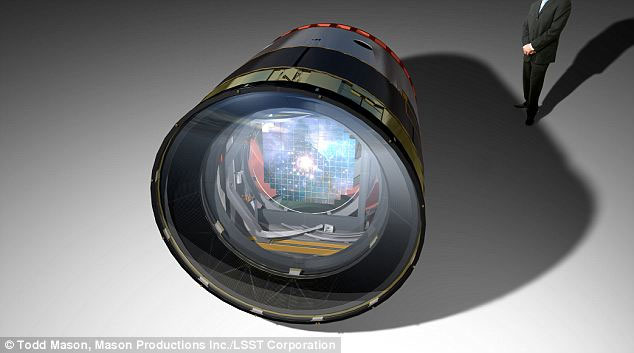The world's largest digital camera
LSST's huge telescope is being designed and built by SLAC National Accelerator Laboratory in the US. It will provide the ability to capture and observe the night sky in the fastest, largest, deepest way ever before.
>>>New tool to help detect aliens
According to the Daily Mail, achieving this is thanks to a 3.2-billion-pixel camera that helps to survey the sky weekly, creating an archive of about 6 million GB of data each year. This is equivalent to an 8 megapixel digital camera that captures 800,000 images per night, but the quality and value of science are certainly not comparable.

LSST telescope model
Extensive monitoring in the universe regularly helps answer important questions about energy and dark matter and studies of near-asteroids, objects within the Kuiper belt, structures our galaxy, basic physics knowledge and other areas of astronomy.
Nadine Kurita, the LSST camera project manager at SLAC, said that with 189 sensors and 3 tons of tightly packed other devices, it is a sophisticated and sophisticated scientific tool that provides excellent opportunities. to have a comprehensive view of the universe. According to Steve Kahn, deputy director of the LSST program, if the schedule is right, the telescope will go into operation in 2014. The current job is to install the main mirror of size 8.4m on top of Cerro Pachón north Chile.
Dark energy is considered a major component of cosmic energy but there are still many mysteries and this is the most important research object.
Reference: Daily Mail
- Camera based on insect eyes
- America is building the world's largest camera
- The world's most powerful digital camera hunts for dark energy
- The world's largest camera was created ... just to capture a panorama of a train
- Panasonic introduces new digital cameras
- Canon produces fully automatic cameras
- Fire detection camera
- See photos of camera origin
- The birth of the camera
- DXG-506V: digital camera
- Wi-Fi card coming soon for digital cameras
- The world's largest 'super' camera to hunt for exoplanets
 Van Allen's belt and evidence that the Apollo 11 mission to the Moon was myth
Van Allen's belt and evidence that the Apollo 11 mission to the Moon was myth The levels of civilization in the universe (Kardashev scale)
The levels of civilization in the universe (Kardashev scale) Today Mars, the sun and the Earth are aligned
Today Mars, the sun and the Earth are aligned The Amazon owner announced a secret plan to build a space base for thousands of people
The Amazon owner announced a secret plan to build a space base for thousands of people